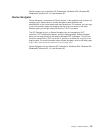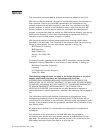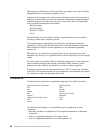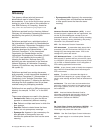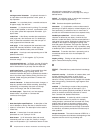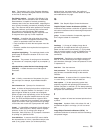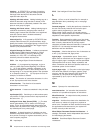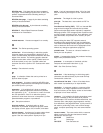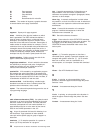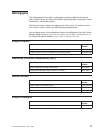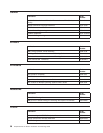euro. The monetary unity of the European Monetary
Union (EMU), introduced alongside national currencies
on the first of January, 1999.
EuroReady product. A product is EuroReady if the
product, when used in accordance with its associated
documentation, is capable of correctly processing
monetary data in the euro denomination, respecting the
euro currency formatting conventions (including the euro
sign). This assumes that all other products (for example,
hardware, software, and firmware) that are used with
this product are also EuroReady. IBM hardware
products that are EuroReady might or might not have
an engraved euro sign key on their keyboards.
exception. A condition that exists when the printer:
v Detects an invalid or unsupported command, order,
control, or parameter value from the host
v Finds a condition of which the host system must be
notified
v Detects a condition that requires the host system to
re-send data
exception highlighting. The markings placed on the
printed page to indicate the location of an error in the
data stream.
execution. The process of carrying out an instruction
or instructions of a computer program by a computer. (I)
(A)
extended binary-coded decimal interchange code
(EBCDIC). A coded character set of 256 eight-bit
characters.
F
font. A family or assortment of characters of a given
size and style; for example, 9-point Bodoni Modern.
(A)
font character set. Synonym for character set.
form. A division of the physical medium; multiple forms
can exist on a physical medium. For example, a roll of
paper might be divided by a printer into rectangular
pieces of paper, each representing a form. An envelope
is an example of a physical medium that has only one
form. The IPDS architecture defines 4 types of form:
cut-sheets, continuous forms, envelopes, and computer
output on microfilm. Each type of form has a top edge,
a front side, and a back side. Synonymous with sheet.
format. (1) A specified arrangement of such things as
characters, fields, and lines, usually used for displays,
printouts, or files. (2) To arrange such things as
characters, fields, and lines. (3) To prepare a document
for printing in a specified format.
form definition. A resource that PSF uses to define
the characteristics of a form; it specifies overlays to be
used (if any), paper source (for cut-sheet printers),
duplex printing, text suppression, the position of
MO:DCA data on the form, and the number of copies
and modifications of a page.
G
GOCA. See Graphic Object Content Architecture.
Graphic Object Content Architecture (GOCA). An
architecture that provides a collection of graphics values
and control structures used to interchange and present
graphics data.
group. A named collection of sequential pages that
form a logical subset of a document.
H
hardcopy. (1) A copy of a display image that is
generated on an output device such as a printer or
plotter and that can be carried away. (T) (2) A printed
copy of machine output in a visually readable form, for
example, printed reports, listings, documents, and
summaries.
hexadecimal. Pertaining to a numbering system with
base of 16; valid numbers use the digits 0 through 9
and characters A through F, where A represents 10 and
F represents 15.
host font. See host resource.
host processor. The processing unit to which the
page printers are attached through a data-transfer
interface.
host resource. A resource found in a system library,
in a user library, or inline in the print data set.
host system. (1) A data processing system that
prepares programs and operating environments for
another computer or controller. (2) The data processing
system to which a network is connected and with which
the system can communicate.
I
image. A pattern of toned and untoned pels that form
a picture.
image data. A pattern of bits, with values of 0 and 1,
that defines the pels in an image. (A 1-bit is a toned
pel.)
Image Object Content Architecture (IOCA). An
architected collection of constructs used to interchange
and present images.
Glossary 33



